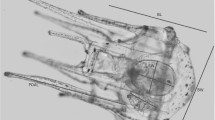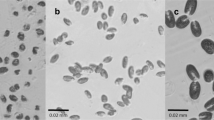Abstract
Four species of microalgae (Chaetoceros muelleri, Tetraselmis suecica, Tahitian Isochrysis sp. (T-iso) and Dunaliella tertiolecta) with distinctly different fatty acid profiles were grown in continuous culture and fed to prawn larvae (Penaeus japonicus, P. semisulcatus and P. monodon) as monospecific diets. The best two diets (C. muelleri and T. suecica) were also fed as a mixed diet. Experiments were run until the larvae fed the control diet of C. muelleri metamorphosed to Mysis 1. The survival and development (i.e. performance) of the larvae were affected by algal diet, and the diets were ranked in the order of decreasing nutritional value: C. muelleri ≥ T. suecica > T-iso > D. tertiolecta. Larvae fed a mixed diet of C. muelleri and T. suecica (2:3 by dry weight) performed as well or better than those fed C. muelleri, and the performance of both these groups of larvae was better than those fed T. suecica. The lipid and carbohydrate compositions of the algae had little or no effect on the lipid and carbohydrate compositions of the larvae or their performance. However, the larvae that performed best (i.e. those fed C. muelleri) had significantly more lipid and carbohydrate than those that performed worst (i.e. those fed D. tertiolecta). Larvae fed C. muelleri or the mixed-algae diet had higher proportions of the essential fatty acids eicosapentaenoic acid [EPA, 20:5(n-3)] and arachidonic acid [ARA, 20:4(n-6)] than the larvae fed on other diets. Furthermore, the larvae fed T. suecica, which showed intermediate performance between larvae fed C. muelleri and T-iso or D. tertiolecta, also had higher proportions of EPA and ARA. Both C. muelleri and T. suecica contained EPA and ARA, but T-iso and D. tertiolecta did not, except for trace amounts of EPA in T-iso. The fatty acid ARA appears to be much more important in the diet of larval prawns than has so far been considered. The level of the essential fatty acid docosahexaenoic acid [DHA, 22:6(n-3)] in the algal diet and the larvae was not related to the performance of the larvae; only C. muelleri and T-iso contained DHA. However, the nauplii contained large proportions of DHA, suggesting that these were sufficient to meet the larval requirements for DHA during their development to Mysis 1. Mixed-algae diets could improve the performance of larvae by providing a more comprehensive range of fatty acids.
Similar content being viewed by others
Author information
Authors and Affiliations
Additional information
Received: 22 April 1998 / Accepted: 3 December 1998
Rights and permissions
About this article
Cite this article
D'Souza, F., Loneragan, N. Effects of monospecific and mixed-algae diets on survival, development and fatty acid composition of penaeid prawn (Penaeus spp.) larvae. Marine Biology 133, 621–633 (1999). https://doi.org/10.1007/s002270050502
Issue Date:
DOI: https://doi.org/10.1007/s002270050502




